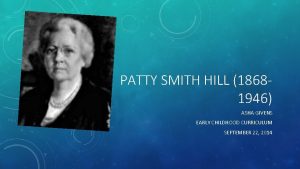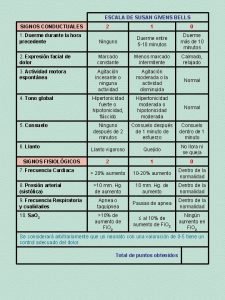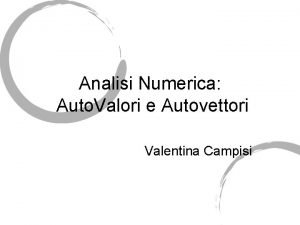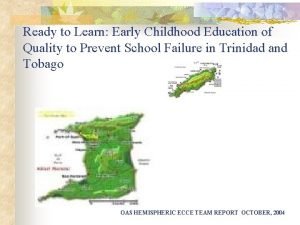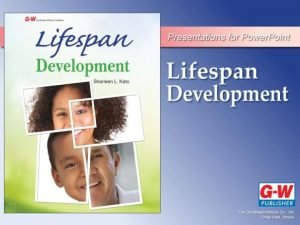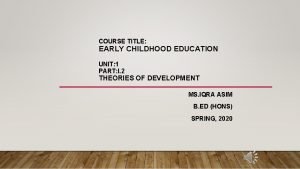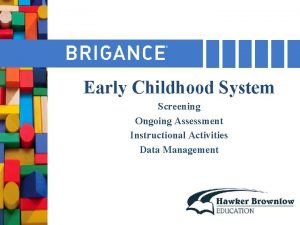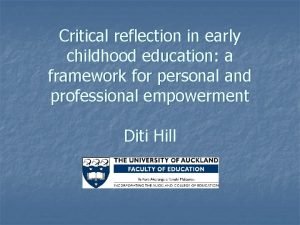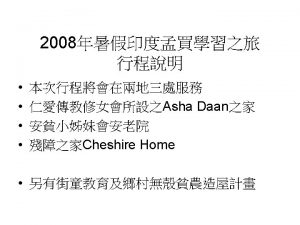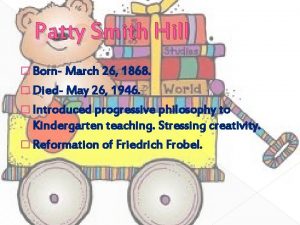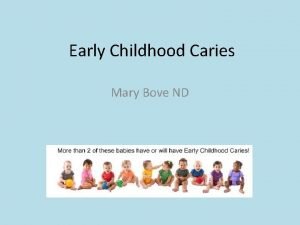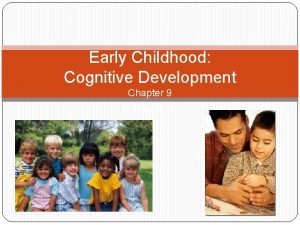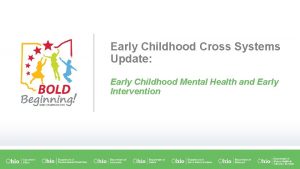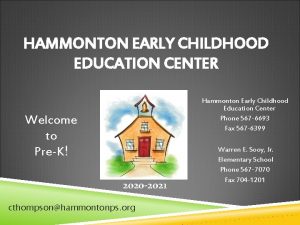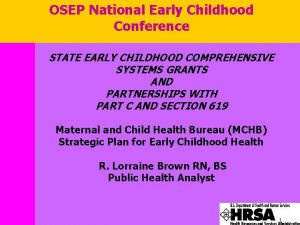PATTY SMITH HILL 18681946 ASHA GIVENS EARLY CHILDHOOD


















- Slides: 18

PATTY SMITH HILL (18681946) ASHA GIVENS EARLY CHILDHOOD CURRICULUM SEPTEMBER 22, 2014

Born near Louisville, Kentucky to Dr. William and Martha Hill. Given much freedom to enjoy outdoor plan and experiment with building materials. Leader of kindergarten movement and an advocate of the value of free play in the education of young children. Quick Facts

Graduated from Louisville Collegiate Institute in 1887. Joined Louisville Kindergarten Training School under the direction of Anna E. Bryant Encouraged by Bryant, she used free play in the classroom to facilitate learning. Education

Investigated the research in the field of child psychology under G. Stanley Hill at Clark University. Later studied John Dewey at the University of Chicago. Spent summer months studying Colonel Francis W. Parker and Luther Gulick, the father of the U. S. playground movement. Challenged the practice of following Friedrich Froebel’s methods of explicitly. Influences

1892: founding member of the International Kindergarten Union (IKU). Spoke about alternative methods of interpretation of Froebel’s idea, suggesting educators should study his theory, but not blindly accept his methodology. Engaged students’ parents in lectures about the educational value of play, the individuality of training based on sensory and motor types, and the causes of children’s activities. Works

1905: Join the faculty at Teachers College at Columbia University. Alternative ideas to Froebel’s theory were slow to be accepted until John Dewey became the head of Columbia University’s Department of Philosophy and Edward Thorndike became the head of Teachers College. 1910: Became the College’s Department of Kindergarten Education and full professor by 1922. Works Con’t

Greatly influenced by John Dewey’s principle of education, especially his theories of progressive schools and moral education. Felt that children needed socialization and free play to develop their full potential. Her classroom were filled with toys, such as cars, trucks, pots, pans, play money, and loose parts, to help children understand their world and engage in pretend play. Works

Developed a new set of blocks, which became known as “Patty Smith Hill blocks. ” Felt Froebel’s constructive blocks were too small for small children to easily manipulate, and Hill’s blocks were more than 16 times larger than those used by Froebel. Children needed to use large muscles and physical strength to move the large blocks. Works

Collaborating with psychologist Jeans Rogers, Hill developed a list of 84 desired kindergarten habits towards which instruction should be directed called “Tentative Inventory of Habits. ” Used at the Horace Mann School at Teachers College as well as the Laboratory School at The University of Chicago and other schools across the country. Wrote several books applying these principles. Works

Retired from Teachers College in 1935 then became involved with the Federal Emergency Nursery Schools Program. Used the funds to finance a neighborhood nursery school called Hilltop for six years until funding ran out. Also known for “Happy Birthday to You, ”- “Good Morning to All. ” Works

MARIA MONTESSORI

Born August 31, 1870 in Italy. Her father was a financial manager for the state-run industry. At the age of 13 she entered an all- boys technical institute to prepare for a career in engineering. However, she changed her mind, deciding to become a doctor instead. She applied to the University of Rome’s medical program but was rejected. With great efforts she gained admittance, opening the door a bit wider for future women in the field. Believed in the need for greater opportunities for women and was recognized in Italy and beyond as a leading feminist voice. Quick Facts

Facing her father’s resistance but armed with her mother’s support she graduated from the medical school in 1896, with high honors, becoming the first female doctor in Italy. Early practice focused on psychiatry Also developed an interest in education, attending classes on pedagogy and immersing herself in educational theory. Led her to observe, and call into question, the prevailing methods of teaching children with intellectual and developmental disabilities. Works

1900: Became co-director of the Orthophrenic School for developmentally disabled children, a new training institute for special education teachers. Studied 18 th and 19 th century French physicians Jean-Marc-Gaspard Itard and Edouard Seguin, who had experimented with the capabilities of disabled children. Approached the task scientifically, carefully observing, and experimenting to learn which teaching method worked best. Works

1907: opened a childcare center in a poor inner-city district, ranged from ages 1 to 6. It became the first Casa dei Bambini (Children’s House), a quality learning environment for young children. The youngsters were unruly at first, but soon showed great interest in working with puzzles, learning to prepare meals, and manipulating materials that held lessons in math. It allowed her to prepare learning environments she believed was conductive to sense learning and creative exploration. She found the resulting improvement remarkable. She spread her research around Europe, also using her platform to advocate for women’s and children’s rights. Works

Developed a program to prepare teachers in the Montessori Method, emphasized on independence, freedom, within limits, and respect for a child’s natural psychological, physical, and social development. She designed learning materials and a classroom environment that fostered the children’s natural desire to learn. 1910 Montessori schools were acclaimed worldwide. Works

1925: more than 1, 000 Montessori schools had opened in the United States 1940: Montessori movement had faded, but it was revived in the 1960 s During WWII, she was forced to flee to India, where she developed Education for Peace and earned two Nobel Peace Prize nominations. She died May 6, 1952. Works

http: //filsonhistorical. org/from-kindergarten-to-Columbiateachers-college-patty-smith-hill-departs-for-new-york/ www. biography. com/maria-montessori amshq. org/Montessori/Bio Sources
 Patty smith hill theory
Patty smith hill theory Principles of growth and development
Principles of growth and development Connie givens
Connie givens Escala de susan givens bell
Escala de susan givens bell Amelia givin library
Amelia givin library Rotazioni di givens
Rotazioni di givens Swot analysis early childhood education
Swot analysis early childhood education Skinner's theory
Skinner's theory Kentucky governor's office of early childhood
Kentucky governor's office of early childhood Eminem early childhood
Eminem early childhood Efq element 1
Efq element 1 Early childhood education in bangladesh
Early childhood education in bangladesh Chapter 7 early childhood ages 3 through 5 answer key
Chapter 7 early childhood ages 3 through 5 answer key Bf skinner early childhood education
Bf skinner early childhood education Brigance readiness activities
Brigance readiness activities Smyths model of reflection
Smyths model of reflection Early childhood directorate
Early childhood directorate Brownsburg early childhood center
Brownsburg early childhood center Prosposed
Prosposed
